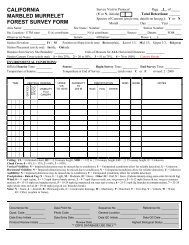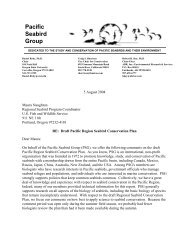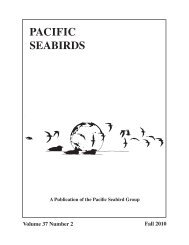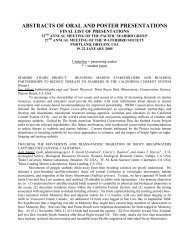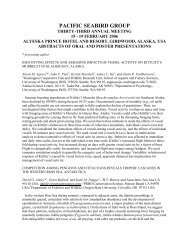PSG 2012 Hawaii abstracts - Pacific Seabird Group
PSG 2012 Hawaii abstracts - Pacific Seabird Group
PSG 2012 Hawaii abstracts - Pacific Seabird Group
You also want an ePaper? Increase the reach of your titles
YUMPU automatically turns print PDFs into web optimized ePapers that Google loves.
abundance at colonies. Sensors recorded ambient noise at Forster’s Tern (Sterna forsteri) breeding<br />
colonies in San Francisco Bay for two breeding seasons. We used an automated method (spectrogram<br />
cross-correlation) to detect and count tern vocalizations from recordings. We calculated mean calling<br />
rates at different time scales and compared these to active nest counts at colonies. Our results show that<br />
acoustic activity was a strong index of colony size within years (2009 r 2 =.84, n=5; 2010 r 2 =.59, n=7) and<br />
a powerful index of change in colony size between years (r 2 =.92, n=5). We also estimated the predictive<br />
power of an acoustic activity index to detect population changes. Quantifying the relationship between<br />
acoustic activity and relative abundance is a fundamental step in designing effective acoustic monitoring<br />
programs for seabirds and other vocalizing wildlife. These tools present low-cost, scalable and<br />
comparable tools for measuring population trends and responses to conservation actions.<br />
MONITORING MARBLED MURRELETS WITH ACOUSTIC SENSORS – COMPARING<br />
AUTOMATED DETECTIONS WITH HUMAN AUDIO-VISUAL MONITORING<br />
Abraham L. Borker* 1 , Matthew W. McKown 1 , Portia Halbert 2 , Cody Sullivan 1 , Bernie R. Tershy 1 , and<br />
Donald A. Croll 1 , 1 CCAL - Department of Ecology and Evolutionary Biology, University of California<br />
Santa Cruz, 100 Shaffer Road, Santa Cruz, CA 95060 USA, aborker@ucsc.edu; 2 California State Parks,<br />
303 Big Trees Park Road, Felton, CA 95060 USA<br />
Acoustic sensors provide a potentially low-cost alternative for monitoring Marbled Murrelets in remote<br />
areas over long survey periods. To assess the efficacy of this approach we compared monitoring<br />
methodologies at 7 sites in the Santa Cruz Mountains (CA) in 2010 – audio-visual surveys by trained<br />
observers and acoustic monitoring with automated acoustic sensors. We compared audio/visual<br />
detections of murrelets by trained observers with acoustic detections of murrelets, identified from sensor<br />
recordings using automated spectrogram cross-correlation. Mean automated acoustic detections were<br />
highly correlated with mean rates of human a/v detections across sites (r 2 =.97 n=7, p=



